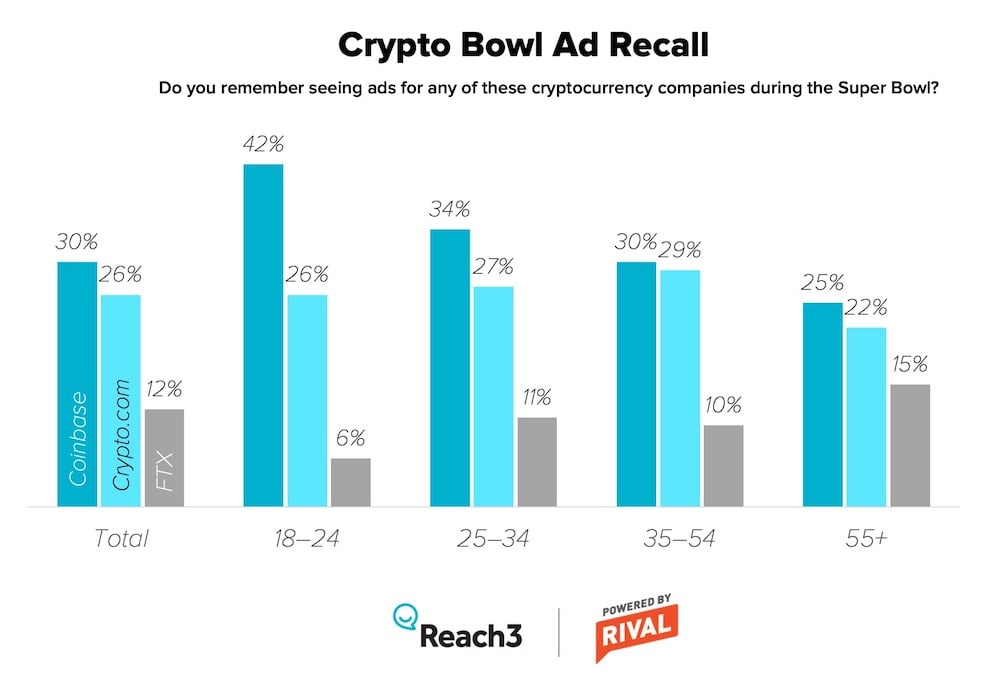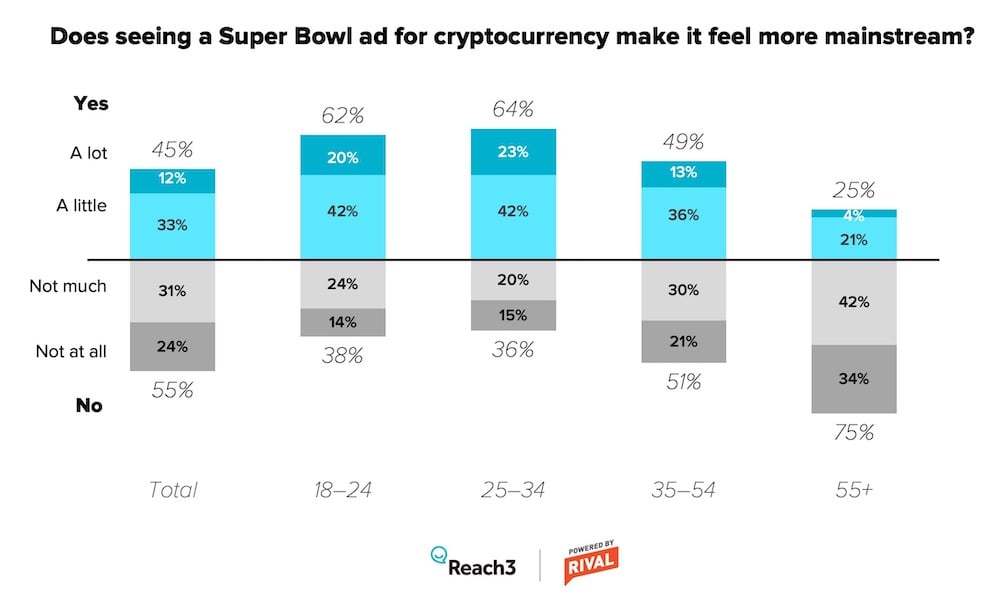Cryptocurrency companies may be missing out on a big piece of the pie if they fail to connect with older generations who have the capital for investment.
While crypto has steadily been making its way into the sports scene, by sponsoring NBA teams or splashing logos across stadium floors, Super Bowl LVI was the first time crypto companies tested themselves on sport’s biggest stage. As Jimmy Kimmel pointed out, this year’s big game felt like “Cryptocurrency awareness day,” with major crypto players spending a reported $6.5 million for a 30-second spot.

We connected with 600 Americans post-game on Sunday night and Monday morning to see how crypto’s much anticipated Super Bowl debut resonated with the public. With the game still fresh in viewers’ minds, we leveraged our conversational approach on Rival’s market research platform to learn more about people’s reactions to ads from Coinbase, crypto.com, and FTX.
Both Coinbase and FTX had significant skin in the game this year, with each promising to give out hundreds of thousands of dollars worth of Bitcoin to viewers. So, when it comes to the final showdown, who came home with a ring?
Who won Super Bowl’s crypto showdown?
Our research shows that Coinbase’s buzzworthy and creative QR code / DVD logo easily won the night. Reminiscent of a scene from The Office, the Coinbase ad enjoyed a 30% recall—the most among all the crypto companies airing Super Bowl spots. Crypto.com came in second with a close 26% recall.

The biggest crypto loser? FTX. Only 12% remember seeing their ads. This was even more pronounced among younger audiences.
Was it worth the ad spend?
We followed up with participants to see how interested they are to learn more about the crypto brands. Of those who recalled seeing any crypto ads, 34% said they would be interested in learning more about crypto. Specifically, among crypto brands, 21% said they would look more into Coinbase, 18% said the same for Crypto.com, but only 8% for FTX.

12% said that seeing a crypto ad during the big game made it feel a lot more mainstream. 33% said it made it feel a little more mainstream. Older generations were much more hesitant to agree though—almost two thirds of those 18-35 (Gen Z and millennials) felt that crypto has become more mainstream, while that drops off dramatically for those above 35.
So crypto is kinda mainstream... but do people understand how it works?
While running ads in the Super Bowl was great for generating awareness—47% of Super Bowl viewers recalled seeing a crypto ad—crypto companies’ biggest hurdle is still in front of them. It will take more than ads and $15 of free Bitcoin to reach certain audiences.
Our conversational research design allowed us to get rich qualitative feedback about people’s unfiltered thoughts on crypto. We found that most participants still felt unsure and hesitant about investing in cryptocurrencies. Buzzwords and Twitter trends are unlikely to sway older audiences. For example, take this feedback from a Boomer:
“[Cryptocurrencies] may be the way of the future, but I am an old-fashioned person who believes in cash, paying for what you can afford and only using credit for the big expenses like home, cars or emergencies. All this new stuff just does not interest me. I want to know where my money is.” – He/Him, 65+
Cryptocurrency companies may be missing out on a big piece of the pie if they fail to connect with older generations who have the capital for investment. To resonate with older consumers, crypto brands need to instill a sense of trust in the system and an understanding about how the tech works. We found that nearly everyone who was uninterested in investing in cryptocurrency was because they didn’t feel comfortable putting money behind what feels like an opaque concept:
“Crypto-currency is too complex and confusing for me. I'm having enough challenges managing my Pay Pal and Zelle mobile banking. It's too much for me to be worrying about cryptocurrency at this time.” – She/Her, 55-64
“I don't understand it. How can a digital currency have value? How can it be mined to get more? It's like it comes from nowhere!” – She/Her, 55-64
“Well, I don't quite have the hang of it. I have a digital wallet but that doesn't get it. Someday perhaps I will understand.” – She/Her, 55-64
FTX tackled the Boomer problem head-on, tapping Larry David to speak to his own generation. Their concept (a funny celebrity in various sketches) is pretty traditional for the Super Bowl, while directly addressing the cynicism around crypto by reframing it around FOMO. However it seems this strategy didn’t pay off. Coinbase’s retro and more millennial-aimed ad strategy delivered the biggest ROI of the night. Although older populations own the most wealth, the steep learning curve and (lack of) willingness to learn about crypto is a particularly high barrier to entry.
Crypto’s future beyond the 2022 Super Bowl
This year’s Super Bowl suggests that crypto companies are willing to invest a lot of money in building awareness for their brands. But our research also clearly shows that paying millions for 30-second spots, featuring older celebrities, or using bouncing QR codes won’t be enough. For crypto to go mainstream, brands need to build trust among all age groups and educate the public how the technology works.
In the short-term, crypto companies might want to focus more on Gen Zs or Millennials, who seem open to this technology. Gen Xers and Boomers will be harder to convince, at least in the short term, so putting ad dollars towards these consumer groups may not deliver ROI.
In the end though, FTX, Crypto.com, Coinbase and other major players in the market will need to invest in ongoing research to really understand consumer motivations and barriers in adopting this technology. Capturing nuances between different consumer segments and demographics—and identifying whitespace opportunities early—will be key to winning in the long-term.
There’s a lot more to unpack about Super Bowl 2022. Stay tuned for our continued series as we delve more into hot topics from Sunday’s big game: ads, diversity, the halftime show, NFTs, and more!

Lianne Frick
Research Consultant







.webp?width=65&height=83&name=A-LIGN_HIPAA%20(1).webp)

